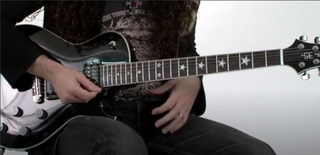Full Shred with Marty Friedman: Taking Licks You’ve Learned from Others and Making Them Your Own
Marty Friedman dishes on how to carve out your own niche when you're creating improvised solos.

Hello, and welcome to my new GW instructional column. It’s good to be back! I hope the ideas and concepts I present here in the coming months will give you inspiration and insight into your own path to musical creativity.
The most important thing I can say is that you should always strive to make your own distinct musical statement with what you play on the guitar.
Once you’ve learned from the examples I present in this column, I would like you to completely disregard the examples themselves and retain only the techniques contained within them.
As soon as you get the idea of where I’m coming from with a certain lick or phrase, I want you to change it into something of your own invention and tap into your own creative curiosity as quickly and fully as possible.
The overall idea is to try your hardest not to sound like everyone else. We all basically play the same stuff, and it is your responsibility to change things around so that you can find your own musical voice. I’m going to start with some basic licks and patterns that everyone knows and plays, and demonstrate a few ways one can add twists and turns in the pursuit of musical phrases that are unpredictable and ultimately unique.
A key concept for me when playing the guitar is to avoid looking at the fretboard as a big block of space across which you need to know dozens of scales and modes. I prefer to view the fretboard in smaller pieces, thinking of just a group of a few frets as a roadmap to little side streets and alleyways, and to concentrate on those little places. Let me demonstrate this concept for you.
FIGURE 1 illustrates a common lick, based on the A blues scale (A C D Eb E G), that you’ll typically hear in metal, rock, blues, jazz and country. There are about five billion different things you can do with just these five notes. FIGURE 2 represents a lick that we have all heard a million times. There’s nothing particularly wrong with the lick, but I’d prefer to
make it more interesting and unpredictable by simply changing the order of the notes slightly, as I do in FIGURE 3.
Notice that I’ve moved the initial hammer/pull on beat one to the 11th and 12th frets (as opposed to the 10th and 11th) and then, on beat two, I added the 12th fret high E note to the beginning of the legato phrase to end up with a five-note shape. To my ears, this lick sounds more interesting than the “standard” lick shown in FIGURE 4.
We can now easily switch a few notes around and end up with FIGURE 5, which is a bit more complex and interesting. If we move the hammer/pull up one fret, we get FIGURE 6, another nice variation on the original idea. Let’s look at another example. We can start with a predictable lick like FIGURE 7 and twist it up to get FIGURES 8 and 9. Similarly, FIGURE 10 presents a standard phrase, and FIGURES 11 and 12 offer twisted deviations.
As a rule, try to avoid anything you’ve heard anyone else play before, unless it’s something you really like and want to play out of choice. This is how to carve out your own niche when you are creating improvised solos.


Get The Pick Newsletter
All the latest guitar news, interviews, lessons, reviews, deals and more, direct to your inbox!

"Upgrading from your entry-level acoustic opens the door to an entirely new world of tonewoods, body shapes, and brands": 6 signs it's time to upgrade from your first acoustic guitar

"I'm past my prime": 5 common excuses for not learning the guitar – and 5 body and mind-boosting reasons you should



![Joe Bonamassa [left] wears a deep blue suit and polka-dotted shirt and plays his green refin Strat; the late Irish blues legend Rory Gallagher [right] screams and inflicts some punishment on his heavily worn number one Stratocaster.](https://cdn.mos.cms.futurecdn.net/cw28h7UBcTVfTLs7p7eiLe-840-80.jpg)







![[L-R] George Harrison, Aashish Khan and John Barham collaborate in the studio](https://vanilla.futurecdn.net/cyclingnews/media/img/missing-image.svg)